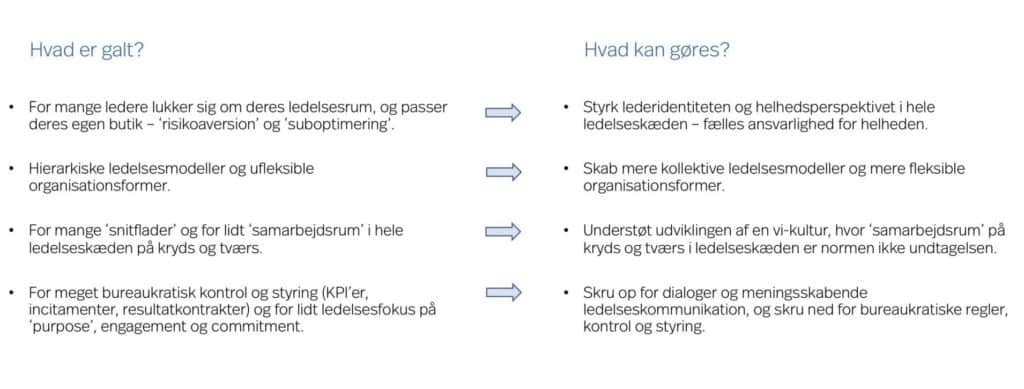What does it take to practice agile leadership in a world that is crying out for flexibility and change, but where control and management are still extremely important? Both in our assumptions about good leadership and in the structure of our organizations. Read on as I thematize an often overlooked aspect of agile leadership: the need for courage as a leadership virtue.
Courage in the sense of putting yourself at risk and challenging the status quo despite doubt and uncertainty, for the good of the organization. This can be perceived as risky for individuals, but for organizations, 'risk aversion' is a far greater risk and a potential impediment to development and learning.
Do you mostly look with your right or left hand?
If control and management of the store is the right hand, it's tempting to run the organization with only that hand at the helm. It provides a nice psychological sense of safety and security. Over the centuries, we've refined the hierarchical organizational form based on the assumption that the resilient organization is one where decision-making power and control can be localized to top management. This image of the resilient organization is coming under pressure in a complex and rapidly changing world, where it is increasingly becoming a harmful illusion of control and resilience.
If the left hand represents the need for learning and development, it takes a lot more courage to get that hand out of your pocket. There is an inherent psychological uncertainty and vulnerability associated with being in a learning position. You're heading into the unknown without knowing exactly where you're going or what challenges you'll encounter along the way. The need for development requires an organization that can collaborate flexibly across professional and organizational boundaries. It also requires leadership that dares to let go of some control, take calculated risks and support experimentation, learning and creativity.
The article continues in the next section.

Curious for more? Download our agile management e-book
In this e-book, you will learn what characterizes agile leadership, not as a one-sided and simplistic leadership skill, but as the ability to balance your leadership in the context in which you lead, and that this form of leadership is not only relevant in pure agile organizations, but for any leader who must navigate in a world of increasing complexity and uncertainty.
Agile leadership takes courage
Agile leadership is all about the ability and courage to read and respond to changing circumstances with a broad repertoire of actions.
This means that as a leader, you are free to use contrasting management approaches and organizational forms regardless of your personal preferences.
Being agile means that you are quick, light and agile in your approach to management and organization.
You must dare to be vulnerable and doubt
We've known it for a long time. Collective and facilitative leadership models create better results.
Agile leadership doesn't require a classic heroic leader who commands the troops with tight control and a cool head. Rather, it requires an anti-hero who dares to let go of the reins and control a little. A leader who dares to be vulnerable and doubt. A leader who doesn't just dare to lead from the front and show the way.
When you as a leader dare to be vulnerable and doubt, you make room for your employees to doubt, ask questions, try new paths and maybe stumble along the way. But it takes courage. We all want to look good in the eyes of others, and it can be a personal challenge to put your doubts and vulnerability on display.
Of course, the agile leader still needs to keep the classic virtues of stable operations, finance and legal, but you need to ensure that you do so with minimal bureaucratic control and management.
The article continues in the next section.
Sign up for our agile management course
2-DAY COURSE IN AGILE LEADERSHIP
Agile leadership is about adapting your leadership and organization to the task at hand. A crucial skill to succeed in your role as a leader today - and in the future.
The agile leader, who is quick and agile in their approach and can lead in constant change, is therefore in high demand.
Leading agile means, among other things, that decision-making power and competence are pushed downwards and outwards in the organization to a much greater extent. Therefore, as a manager, you must be able to lead across organizational forms, and it is important that you can create a team and learning culture with collaboration spaces across organizational boundaries.
This intensive course will equip you to lead in an agile way. We work on how you can use agility in your management, based on your specific management task. You will be trained in a number of essential management tools to strengthen your daily management and learn how to create an agile and learning culture.
The courageous leader creates courageous organizations
The courage of agile leadership is also about making the organization more courageous. This can be done by actively creating space to lead upwards. It is dangerous for an organization if there is no room to lead upwards and top management is not made aware of the consequences of their decisions.
As a manager, you play a key role in encouraging employees to bring information upwards and challenge management decisions. If you succeed in creating a sense of security, employees are more likely to contribute with suggestions for strategy and the direction the organization should take. Involvement leads to co-ownership, and you'll achieve far greater agility in your organization.
Read more about leading upwards in this article
But just as it takes courage to doubt, it also takes courage to lead upwards. That's why it's important that senior leaders and managers work together to create a culture of upward leadership. The ideal is "the good collaboration space", where there is a high degree of common goals, shared knowledge and trust between the management chains across the board, and where dialog is used to find good solutions.
Cultivate and empower the courage for agile leadership
So, first and foremost, agile leadership requires courage. Here's a summary of where to start and what to look out for if you want to strengthen courage in your organization:

You can also read:
Leading in a vuca world and how to master conflicting leadership styles in this article on versatility
This article about personal leadership.
Watch this video on strengths-based leadership and versatility




